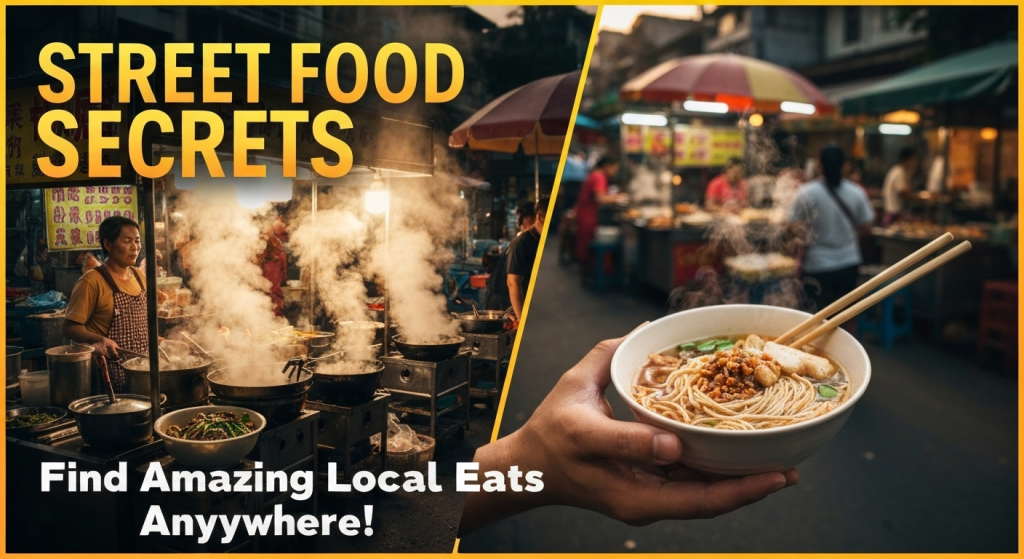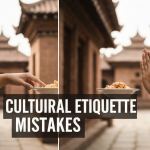Street food hunting has become my passion over the past five years. As a professional food explorer, I’ve eaten my way through countless cities, from Bangkok’s bustling markets to Mexico City’s taco stands. The thrill of finding that perfect local bite never gets old.
My name is Mahnoor Farooq, and I’ve spent half a decade perfecting the art of street food discovery. What started as curiosity during my travels turned into expertise through thousands of meals, countless conversations with vendors, and more than a few stomach adventures. Today, I’ll share the exact methods I use to find amazing local eats in any city.
Street food represents the soul of a place. It’s where locals eat, where traditions survive, and where you’ll taste flavors that restaurants can’t replicate. But finding the good stuff isn’t always easy. Tourist traps exist everywhere, and bad street food can ruin your day.
Why Street Food Hunting Matters
Street food tells stories that fancy restaurants never could. When I bite into a perfectly spiced samosa from a cart in Delhi or savor fresh ceviche from a beach vendor in Peru, I’m tasting generations of knowledge.
Local vendors often use family recipes passed down through decades. Their techniques come from necessity, not culinary school. They know how to make simple ingredients sing because their livelihood depends on it.
The economic impact matters too. Street food vendors typically earn modest incomes and support their families through these small businesses. When you buy from them, your money stays in the local community.
Street food also offers incredible value. You can eat like royalty for the price of a coffee back home. During my travels, I’ve had meals that cost less than two dollars but provided more satisfaction than hundred-dollar tasting menus.
| Benefits of Street Food | Why It Matters |
|---|---|
| Authentic flavors | Recipes passed down through generations |
| Local community support | Money goes directly to families |
| Incredible value | High-quality meals at low prices |
| Cultural experience | Eat where locals eat |
| Fresh ingredients | High turnover means fresher food |
The Psychology Behind Great Street Food
Great street food vendors understand something that many restaurants miss: consistency builds loyalty. When I find a vendor whose food tastes exactly the same every visit, I know they’ve mastered their craft.
The best vendors develop emotional connections with their customers. They remember your preferences, ask about your family, and take pride in feeding you well. This relationship creates accountability that goes beyond just making money.
Location psychology plays a huge role too. Vendors in busy local areas must maintain quality to survive. They can’t rely on tourist traffic, so they focus on keeping neighborhood customers happy.
Timing becomes crucial. The best vendors know exactly when to start cooking each item. They understand peak hours, weather patterns, and local eating habits. This knowledge ensures you get food at its absolute best.
My Proven Street Food Discovery Methods
The Local Network Approach
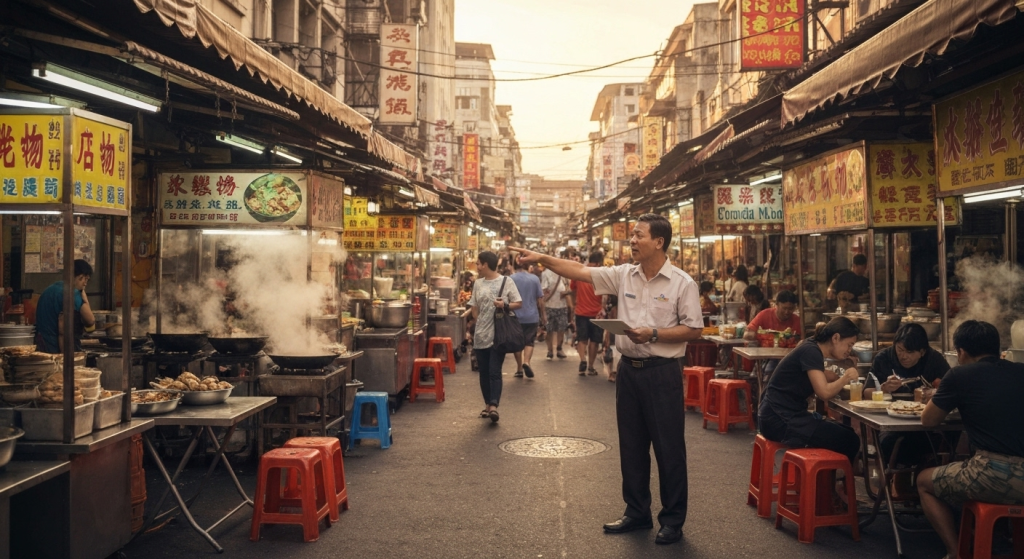
Building relationships with locals remains my most effective strategy. Taxi drivers, hotel staff, and shopkeepers know where the good food hides. They eat in their neighborhoods every day and have strong opinions about quality.
I always ask specific questions: “Where do YOU eat lunch?” instead of “What’s good around here?” The first question gets honest answers, while the second often leads to tourist recommendations.
Social media provides another local network. I search hashtags in the local language and look for photos posted by residents, not tourists. Local food bloggers often share hidden gems that guidebooks miss.
The Follow-the-Crowds Strategy
Crowds don’t lie, but you need to identify the right crowds. I look for lines of locals, not tourists with cameras. Office workers grabbing quick lunches usually know the best spots in their area.
Peak meal times reveal the most about food quality. If a stall stays busy during lunch rush while others sit empty, there’s a reason. Locals vote with their feet and stomachs.
However, I’ve learned to distinguish between different types of crowds. Sometimes people gather for novelty, not quality. The key is observing whether customers return regularly.
The Sensory Investigation Method
Your senses provide crucial intelligence about street food quality. Fresh ingredients smell vibrant and appealing. Old oil has a distinct, unpleasant odor that warns of poor quality.
Visual cues matter enormously. Clean cooking surfaces, organized ingredient displays, and proper food storage indicate professionalism. Vendors who take pride in their setup usually take pride in their food.
Sound tells stories too. The sizzle of fresh ingredients hitting hot surfaces differs from the quiet bubbling of overused oil. Active cooking sounds generally indicate fresher food.
| Sensory Clue | Good Sign | Warning Sign |
|---|---|---|
| Smell | Fresh, appetizing aromas | Rancid oil, sour odors |
| Sight | Clean setup, bright colors | Dirty surfaces, dull food |
| Sound | Active cooking, sizzling | Silence, minimal activity |
| Touch | Warm, fresh-served food | Cold, sitting-out food |
The Strategic Timing Technique
Timing your street food adventures makes the difference between amazing and mediocre experiences. I’ve learned that arriving at the right moment often matters more than finding the right vendor.
Early morning visits reveal breakfast specialists who take pride in starting the day right. These vendors often prepare everything fresh because they know customers need energy for their day ahead.
Lunch rushes show which vendors can handle pressure while maintaining quality. If food quality drops during busy periods, it reveals poor preparation or shortcuts in cooking methods.
Late afternoon often provides the best deals and most relaxed interactions with vendors. They have time to chat and might offer samples or cooking tips.
Common Street Food Mistakes to Avoid
Tourist Trap Indicators
Certain signs immediately identify tourist-focused vendors who prioritize profit over quality. Multilingual menus with pictures often indicate inflated prices and simplified flavors designed for foreign palates.
Vendors positioned directly at major tourist attractions typically charge premium prices for average food. The prime location allows them to capture passing traffic without building repeat business.
Aggressive selling tactics usually indicate desperation or overpricing. Great food vendors let their aromas and satisfied customers do the marketing. They don’t need to chase down customers.
Food Safety Red Flags
Raw ingredients sitting uncovered in hot weather pose serious health risks. Proper vendors use cooling methods or cook ingredients frequently enough to prevent spoilage.
Vendors who don’t wash utensils between orders create cross-contamination risks. I always observe hygiene practices before ordering, especially regarding hand-washing and utensil cleanliness.
Water sources matter tremendously. Ice made from questionable water can cause serious illness. I stick to hot beverages and avoid ice unless I’m confident about water quality.
Cultural Misunderstandings
Expecting familiar flavors often leads to disappointment. Street food reflects local tastes, which might include spice levels, flavor combinations, or textures that seem unusual to outsiders.
Rushing the experience misses the point entirely. Street food culture often involves social interaction, patience, and appreciation for the cooking process. Treating it like fast food shows disrespect.
Bargaining inappropriately can offend vendors who already offer fair prices. Most street food operates on thin margins, and excessive haggling suggests you don’t understand the value being provided.
Regional Street Food Strategies
Southeast Asian Markets
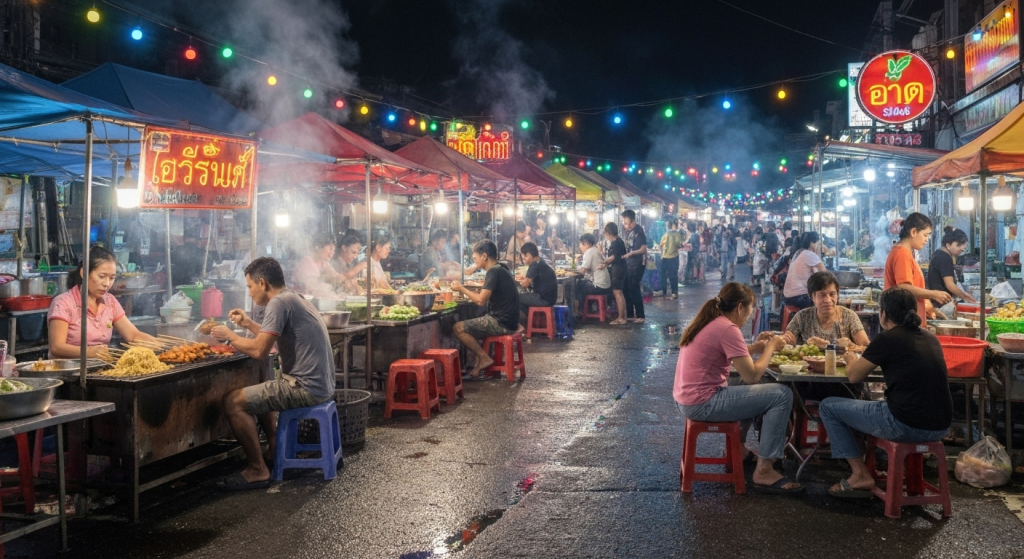
Southeast Asian street food scenes operate differently from Western food cultures. Vendors often specialize in one or two dishes perfected over years. Don’t expect extensive menus.
Night markets provide the best variety and atmosphere. Vendors prepare for these events all day, ensuring peak quality during evening hours. The social atmosphere enhances the entire experience.
Spice tolerance becomes crucial. What locals consider mild might overwhelm unprepared palates. I always ask vendors to adjust spice levels and gradually work up to local standards.
Latin American Street Culture
Latin American street food revolves around fresh ingredients and bold flavors. Vendors often prepare components throughout the day and assemble dishes to order, ensuring maximum freshness.
Breakfast culture differs significantly from other regions. Heavy, protein-rich morning meals fuel long work days. Don’t expect light options during early hours.
Family traditions run deep. Many vendors represent multi-generational businesses with recipes that haven’t changed in decades. Respecting these traditions builds better relationships and often leads to special treatment.
European Urban Food Scenes
European street food varies dramatically between regions. Northern European cities focus on hearty, warming foods, while Mediterranean areas emphasize fresh, light options.
Market timing matters more in Europe than other regions. Many vendors only operate during specific hours or days. Research local market schedules to avoid disappointment.
Quality standards tend to be higher but prices reflect this difference. European street food costs more than Asian equivalents but often provides larger portions and premium ingredients.
Building Relationships with Vendors
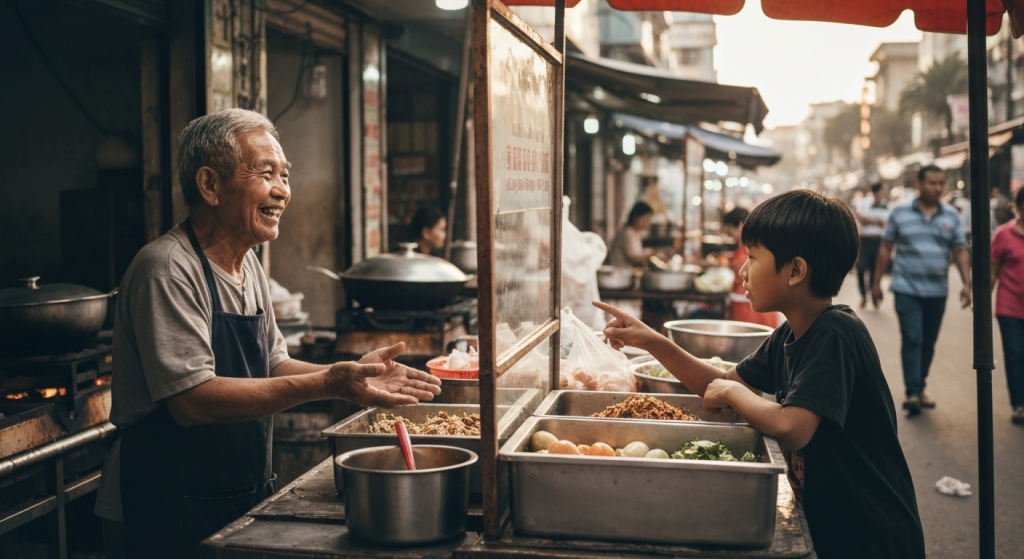
Communication Strategies
Language barriers don’t have to prevent great street food experiences. Pointing, smiling, and showing genuine interest in their craft usually overcome communication challenges.
Learning basic food vocabulary in the local language shows respect and often leads to better service. Simple words like “spicy,” “mild,” and “delicious” go a long way.
Non-verbal communication matters tremendously. Watching how they prepare food, showing appreciation for their skills, and being patient during busy periods builds rapport quickly.
Cultural Respect Principles
Understanding local eating customs prevents embarrassing mistakes. Some cultures have specific ways to eat certain foods, and following these practices shows cultural awareness.
Payment methods vary by region. Some vendors only accept cash, others use mobile payments. Having appropriate payment ready shows preparation and respect for their business model.
Tipping practices differ globally. Research local customs to avoid under-tipping or over-tipping, both of which can create awkward situations.
Advanced Street Food Hunting Techniques
The Competition Analysis Method
Observing how vendors position themselves relative to competitors reveals quality differences. Superior vendors often operate confidently near competitors because they trust their food will speak for itself.
Price analysis helps identify value leaders. The cheapest option isn’t always the best value, but significant price differences usually indicate quality variations or different target markets.
Menu complexity provides clues about focus and expertise. Vendors who do many things often do nothing exceptionally well. Specialists who focus on perfecting fewer dishes usually provide better experiences.
The Supply Chain Investigation
Watching when and how vendors receive ingredients reveals their commitment to freshness. Early morning deliveries of fresh produce indicate daily purchasing and maximum freshness.
Vendor relationships with suppliers often indicate reputation within the local food community. Respected vendors receive priority treatment and better ingredient selection from suppliers.
Storage methods reveal professionalism levels. Proper refrigeration, clean storage containers, and organized ingredient displays indicate systematic approaches to food safety.
The Weather Strategy
Weather conditions dramatically affect street food quality and availability. Hot weather requires careful attention to food storage and turnover rates. Cold weather might limit certain menu options.
Rain affects both food quality and vendor operations. Covered vendors continue operating normally, while exposed vendors might struggle to maintain quality during wet weather.
Seasonal ingredients create opportunities for unique experiences. Vendors often feature special items during peak seasons, providing flavors that aren’t available year-round.
| Weather Condition | Best Food Types | Foods to Avoid |
|---|---|---|
| Hot & Sunny | Grilled items, fresh fruits | Dairy-based foods, mayo |
| Cold Weather | Soups, hot beverages | Cold salads, ice cream |
| Rainy Days | Covered stalls only | Anything exposed to elements |
Technology Tools for Street Food Discovery
Social Media Reconnaissance
Instagram provides visual previews of food quality and presentation. I search location tags and recent posts to identify active vendors with appealing offerings.
Local Facebook groups often share recommendations and warnings about street food vendors. These groups provide insider knowledge that guidebooks and tourist resources miss.
TikTok reveals trendy spots and local favorites through short video content. Vendors featured regularly by locals usually maintain consistent quality to support their social media presence.
Navigation and Translation Apps
Google Translate’s camera feature helps read menus and communicate with vendors who don’t speak common languages. This technology opens opportunities in areas where language barriers previously prevented exploration.
Maps applications help locate highly-rated street food areas and provide user reviews from multiple sources. Combining multiple review platforms provides more complete pictures of vendor quality.
Food delivery apps often list street food vendors, providing additional information about their offerings, prices, and customer feedback. However, delivery ratings don’t always reflect the full street food experience.
Safety and Health Considerations
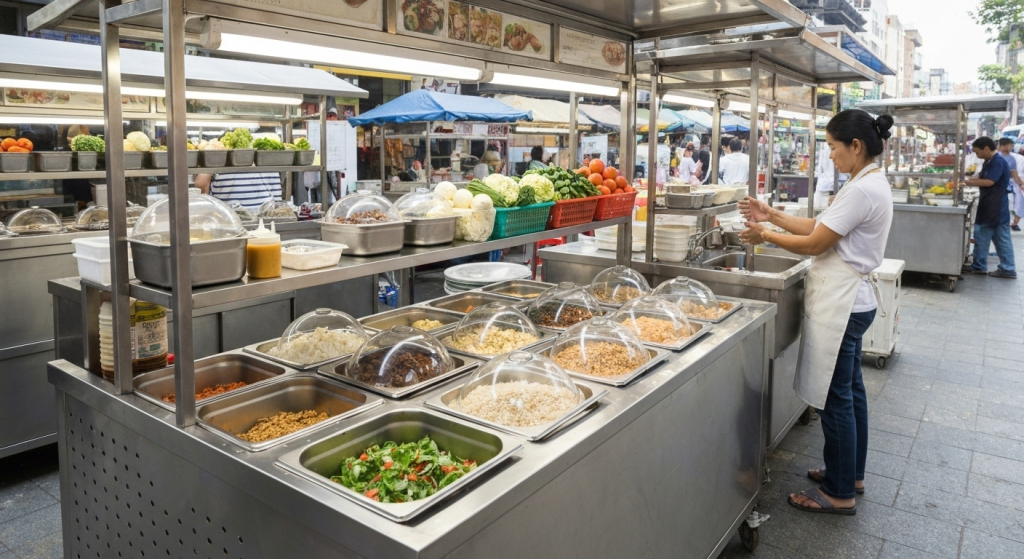
Personal Health Strategies
Building digestive tolerance gradually prevents uncomfortable situations during food exploration. I start with milder options and slowly work toward more adventurous choices.
Carrying basic digestive remedies provides peace of mind during street food adventures. Anti-diarrheal medication, antacids, and probiotics help manage minor digestive issues.
Staying hydrated becomes crucial, especially in hot climates or when eating spicy foods. However, water sources require careful consideration in areas with questionable water quality.
Risk Assessment Skills
Evaluating vendor cleanliness helps identify potential health risks before ordering. Clean hands, utensils, and cooking surfaces indicate professional approaches to food safety.
Understanding local health standards helps calibrate risk tolerance. What’s considered safe in one culture might require adjustment in others, but locals usually know their own standards well.
Trusting instincts about food quality prevents most problems. If something looks, smells, or tastes off, it’s better to skip it than risk illness during travels.
Economic Impact and Sustainability
Supporting Local Communities
Street food purchases directly support local families and contribute to community economic health. These micro-businesses often represent primary income sources for vendors and their families.
Choosing local vendors over international chains keeps money within communities and supports traditional food cultures that define local identity.
Paying fair prices without excessive bargaining shows respect for vendor skills and helps maintain sustainable business models that benefit entire communities.
Environmental Considerations
Street food often uses fewer resources than restaurant meals, requiring less energy for preparation and creating less waste through simpler packaging.
Local sourcing reduces transportation impacts while supporting regional agriculture and keeping supply chains short and sustainable.
However, single-use packaging creates environmental challenges. Some vendors offer options to reduce packaging waste, and bringing your own containers sometimes works in appropriate situations.
Frequently Asked Questions
How do I know if street food is safe to eat? Look for vendors with high turnover, clean cooking areas, and proper food storage. If locals eat there regularly and the food is cooked fresh, it’s usually safe.
What if I can’t speak the local language? Point to what others are eating, use translation apps, or learn basic food words. Most vendors appreciate your effort and will help you order something good.
How much should I tip street food vendors? Tipping varies by country. In some places, rounding up the bill is enough. In others, no tip is expected. Research local customs before you travel.
What should I do if the food is too spicy? Don’t drink water – it spreads the heat. Try dairy products, bread, or sugar to cool your mouth. Ask vendors to make it milder next time.
Conclusion
Finding amazing street food requires patience, observation, and respect for local culture. After five years of exploration, I’ve learned that the best discoveries happen when you approach vendors with genuine curiosity and open minds.
The techniques I’ve shared work because they focus on understanding local food cultures rather than imposing outside expectations. When you eat where locals eat, follow their timing, and show appreciation for their craft, you’ll discover flavors that will stay with you forever.
Street food hunting isn’t just about finding good meals – it’s about connecting with communities, supporting local businesses, and experiencing cultures through their most essential expression: food. Every bite tells a story, and every vendor has knowledge worth learning.
Start with one technique from this guide and practice it during your next food adventure. Build your skills gradually, trust your instincts, and remember that the best street food experiences come from genuine connections with the people who dedicate their lives to feeding others well.

